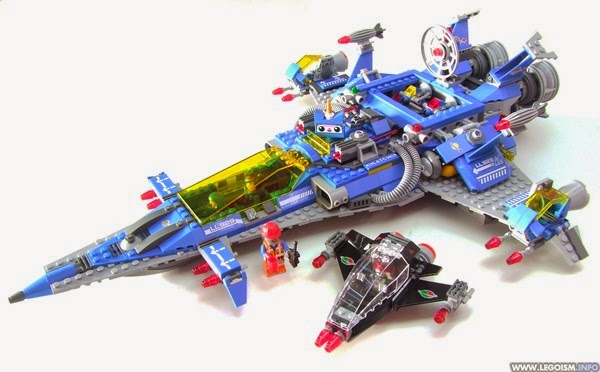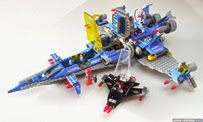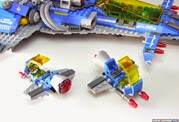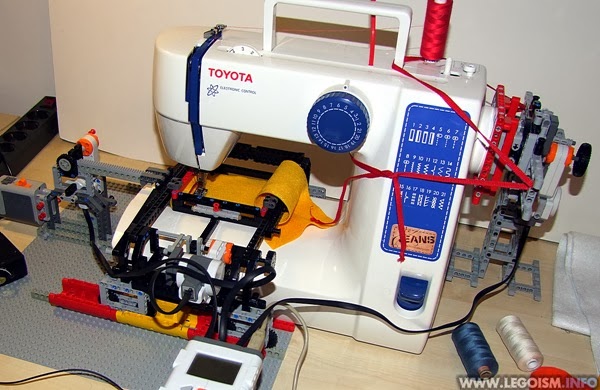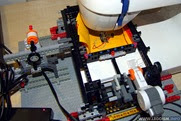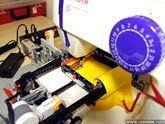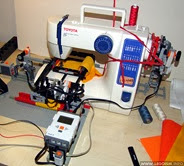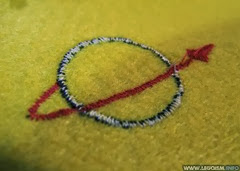I know this is primarily a Technic/Mindstorms site, but I like Classic Space as well ― as do many AFOL's in their mid-thirties nowadays. And so I just couldn't resist buying an official neo-Classic Space set that has recently been launched along with the Lego Movie: a 70816 "Benny's Spaceship, Spaceship, SPACESHIP!". It consists of 903 pieces and is by far the largest ever set in the Classic Space department. It's actually, in terms of part count, the second largest set in the overall Space family, not counting the Star Wars monsters. Despite the name, this set actually consists of two craft.
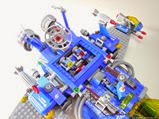 Design is a very personal thing, and while this spaceship perhaps isn't as elegantly streamlined as other LEGO starships of the post-classic era, it is supposed to be a remake of the Classic Space, and I find it very faithful to its design principles that focus on function rather than spectacular looks. As one would expect from a Neo-Classic, it is mostly blue-grey, with a trans-yellow cockpit canopy. The secondary craft is more of a Blacktronesque thing, certainly more modern, and its black-red theme works nicely, too.
Design is a very personal thing, and while this spaceship perhaps isn't as elegantly streamlined as other LEGO starships of the post-classic era, it is supposed to be a remake of the Classic Space, and I find it very faithful to its design principles that focus on function rather than spectacular looks. As one would expect from a Neo-Classic, it is mostly blue-grey, with a trans-yellow cockpit canopy. The secondary craft is more of a Blacktronesque thing, certainly more modern, and its black-red theme works nicely, too.
The Big Blue has also a handful of features: openable cockpit with three minifig seats, openable mid-section, rotatable dish antenna in the rear, and ― the main party piece ― wings that can extend outwards, thus freeing the room for twin rocket launchers otherwise concealed in the hull to shoot. This is done cleverly by pushing the rear rocket, which in turn widens the wings using Technic beams inside. There are also smaller "Antenna" shooters, based on part 15301c01.
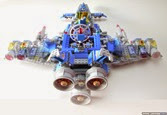 In the middle compartment there are extra seats, some tools and a power generator (a reactor of sort?) is visible in the rear behind the window, which is pretty cool. In the rear there are two droids with their auxiliary equipment. Despite being neat, I have a slight feeling that the front of the ship could have held some more functionality than openable cockpit. But perhaps I'm just spoiled. There are two small, detachable ships at the ends of the wings. They have to flip one wing upwards to allow connection to the mothership, and it is nice that everything is symmetric, so both mini-ships fit on both wings. They can carry one minifig each. The smaller ship offers an openable canopy for its one-man cockpit, and that's about it, though one could hardly conceive of more functionality crammed into this small craft.
In the middle compartment there are extra seats, some tools and a power generator (a reactor of sort?) is visible in the rear behind the window, which is pretty cool. In the rear there are two droids with their auxiliary equipment. Despite being neat, I have a slight feeling that the front of the ship could have held some more functionality than openable cockpit. But perhaps I'm just spoiled. There are two small, detachable ships at the ends of the wings. They have to flip one wing upwards to allow connection to the mothership, and it is nice that everything is symmetric, so both mini-ships fit on both wings. They can carry one minifig each. The smaller ship offers an openable canopy for its one-man cockpit, and that's about it, though one could hardly conceive of more functionality crammed into this small craft.
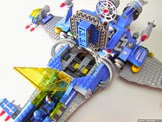 While it doesn't suffer from any construction issues, I found the large ship somewhat fragile. Not its hull, which is fairly strong and sturdy, but rather plenty of details such as wings, missile launchers or the dish antenna, that need the slightest of forces to detach. It's fine for playing on the table top, but I guess waving it around may result in some (fortunately, repairable) damage.
While it doesn't suffer from any construction issues, I found the large ship somewhat fragile. Not its hull, which is fairly strong and sturdy, but rather plenty of details such as wings, missile launchers or the dish antenna, that need the slightest of forces to detach. It's fine for playing on the table top, but I guess waving it around may result in some (fortunately, repairable) damage.
Both ships are fun to build, and personally I've been positively surprised by the amount of hidden Technic parts and the clever way they are used to allow the ship to be built in steps, yet effortlessly connected together when everything is done. A bit of Technic is responsible also for the wing-extending mechanism.
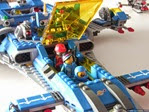 At over 900 parts, this is a good parts supply set, and actually the only one available if you intend to build Neo-Classic yet prefer to buy new. A nice cockpit canopy, launchers, lots of bricks and technical details that are useful everywhere, arches and wedges, and many other fine parts are included here. There are five minifigs, all from the movie ― four humans (or humanoids?) and the Astro Kitty. Benny, the Neo-Classic pilot, with his worn-off chest logo and a simulated crack on the helmet, is a clever tongue-in-cheek reference, especially to the old helmets that really are prone to breaking. (I must have broken at least a third of mine at the time.)
At over 900 parts, this is a good parts supply set, and actually the only one available if you intend to build Neo-Classic yet prefer to buy new. A nice cockpit canopy, launchers, lots of bricks and technical details that are useful everywhere, arches and wedges, and many other fine parts are included here. There are five minifigs, all from the movie ― four humans (or humanoids?) and the Astro Kitty. Benny, the Neo-Classic pilot, with his worn-off chest logo and a simulated crack on the helmet, is a clever tongue-in-cheek reference, especially to the old helmets that really are prone to breaking. (I must have broken at least a third of mine at the time.)
PROS & CONS
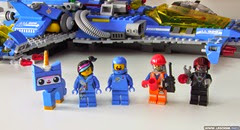 + Good parts supply for Neo-Classic Space
+ Good parts supply for Neo-Classic Space
+ Fun to build and play with
+ Lots of nice details
+ Interesting building techniques, especially extendable wings
- Somewhat fragile
- A bit short on functionality at the front
VERDICT
Among the largest and coolest Space sets LEGO has ever released, particularly as a true flashback to the Classic Space days with a sense of humour. But it is fun to play with as well, though one could imagine this is a set likely to be bought by many AFOL's and shall either be used as an exotic new parts supply, or a display piece for the living room shelf.

